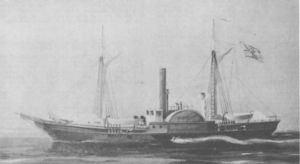USS Water Witch (1851)

USS Water Witch
|
|
| History | |
|---|---|
|
|
|
| Name: | USS/CSS Water Witch |
| Laid down: | 1851 |
| Commissioned: | 1853 |
| Fate: |
|
| General characteristics | |
| Displacement: | 464 tons |
| Length: | 163 ft (50 m) |
| Beam: | 24 ft 4 in (7.42 m) |
| Draft: | 11 ft 9 in (3.58 m) |
| Propulsion: | steam |
| Complement: | 64 officers and enlisted |
| Armament: | 4 32-pdrs., 1 12-pdr.sb., 1 20-pdr. P.r., 4 32-pdrs. |
The third USS Water Witch was a wooden-hulled, sidewheel gunboat in the United States Navy during the American Civil War. She is best known as the ship fired on by Paraguay in 1855. In 1864 she was captured by the Confederate States Navy, and subsequently was taken into that Navy as CSS Water Witch.
Water Witch was launched by the Washington Navy Yard in 1851 and was commissioned during the winter of 1852–53, Lieutenant Thomas Jefferson Page in command.
On 8 February 1853, the gunboat set sail from Norfolk, Virginia, for an extended exploration and survey voyage along the Atlantic coast of the southern portion of South America and of the rivers which drain that part of the continent. Over the next few years, she conducted surveys of the rivers in Paraguay, Argentina, and Uruguay. In February 1855, while the little steamer was surveying the Río de la Plata basin, she was fired upon by the Paraguayan Fort Itapirú. The bombardment killed one member of her crew (helmsman Samuel Chaney) and ended her surveying mission on the river. The gunboat, however, continued her mission in other areas of the southeastern coast of South America until 1856. On 8 May 1856, she returned to the Washington Navy Yard for repairs and went out of commission on the 12th.
The ship recommissioned briefly during the summer of 1858, but her next real active service came after yet another recommissioning on 17 September of that same year. She headed for the coast of South America as part of the Paraguay expedition under Flag Officer William B. Shubrick to exact an apology and an indemnity from Paraguay over the incident which had occurred in 1855. In January 1859, Water Witch and Fulton arrived in Asunción, the capital of Paraguay; and, backed by the warships, an American commissioner, James B. Bowlin, began negotiations with the Paraguayans. As a result of that expedition, Paraguay extended a satisfactory apology to the United States, indemnified the family of the slain Water Witch crewman, and granted the United States a new and highly advantageous commercial treaty.
...
Wikipedia
